Classification Kingdom Animalia (Vertebrates Part 2)
Greeting to steemians all over the world, In my last post Part 1, I did not complete the classes in the vertebrate group. I gave brief details on Mammalia and Aves, promising to complete the others later. Today we will be looking at Reptilia, Amphibia, Agnatha, etc.
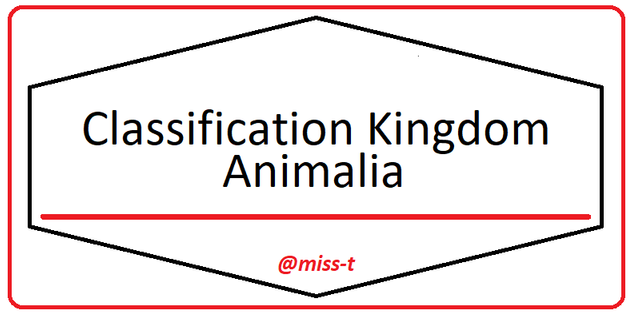
Reptilia
Reptiles evolved from amphibians and fall under the class of organisms to adapt to life on land. They are about 10 000 species and are cold-blooded animals with light skulls. Reptiles have powerful jaw actions, tail and dermal scales all over the body. Some characteristics are:
- They are creeping and burrowing animals
- They are cold-blooded animals (mention above)
- They have dry and rough skin
- They don't have glands (link Mammals)
- They may or may not have limbs (snakes do not have limbs)
- They do not have external ears
Examples
 Collection of images from Pixabay.com
Collection of images from Pixabay.com
| Order | Examples |
|---|---|
| Squamata | Lizards, Snakes |
| Testudines | Turtles, Tortoises, Terrapins |
| Crocodilia | Crocodiles, Alligators |
| Sphenodontia | Tuataras |
Amphibia
Amphibia (living a double life) are organisms that live both on land and water. Amphibia is characterized by four limbs for movement on land, and slip moist thin skin. Amphibia did not have scales except for the caecilians with scales skin. More characteristics
- They live on both land and water.
- Their body is divided into head and truck
- They have scaleless bodies
- Some adults have gills for respiration.
- Fertilization is external
- Water is the host for breeding
Examples
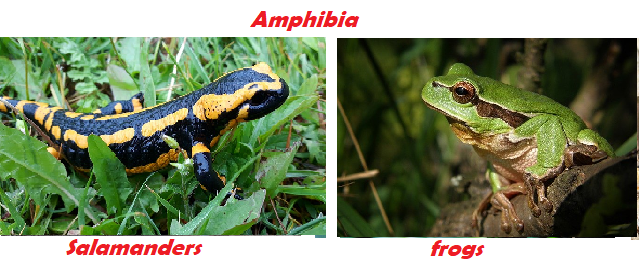 Collection of images from Pixabay.com
Collection of images from Pixabay.com
| Order | Examples |
|---|---|
| Caudata | Salamanders |
| Anura | frogs, and toads |
| Apoda (Gymnophiona) | Caecilians |
Agnatha
Agnatha class has the earliest vertebrates, which were found about 500 million years ago and have cartilaginous skeletons. Agnatha is a class of fish (Lamprey, Hagfish) that don't have paired fins or stomachs with flexible rod-like cord cells called a notochord.
- They don't have true jaws
- They don't have ribs
- They don't have shoulders or pelvis
- They don't have paired fins (mention above)
- No differentiation of the skell and the vertebral column
- They have a light-sensitive pineal eye
- Fertilization is outside the body
Examples
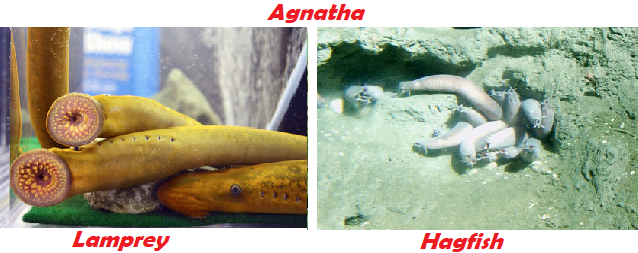 Collection of images from Flickr.com
Collection of images from Flickr.com
- Lamprey (Parasite) which has a jawless sucking mouth used to suck fluid from its host(Fish)
- Hagfish (slime fish)
Osteichthyes
Osteichthyes are cold-blooded vertebrates that cover all bony fishes. There are over 30 000 species of bony fish making the Osteichthyes the largest class of vertebrates. These are jawed fishes covering over 90% of the fish species excluding Agnatha (Lamprey and Hagfish).
- They are freshwater habitats
- They are cartilaginous fishes
- They are endoskeleton (made of bones)
- They have paired fins (for support)
- They have a swim or air bladder (prevent them from sinking)
- They have one pair of gill open
- Their skin is covered with scales
- Fertilization is an external and direct development
Examples
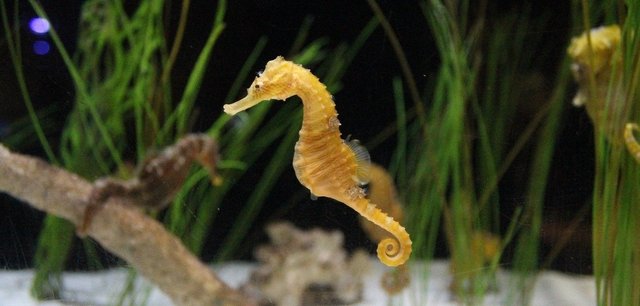 Image source Pixabay.com (Sea horse)
Image source Pixabay.com (Sea horse)
| Group | Order | Examples |
|---|---|---|
| Marine bony fishes | Hippocampus | Sea horse |
| - | Exocetus | Flying fish |
| - | Lophius | Angler fish |
| Freshwater bony fishes | Labeo Rohita | Rohu |
| - | Labeo Catla | Katla |
| - | Clarias | Walking catfish or Magur |
| Aquarium bony fishes | Betta Splendens | Fighting fish |
| - | Pterophyllum | Angelfish |
| Lungfishes | Lepidosiren | - |
| - | Neoceratodus | - |
Chondrichthyes
Chondrichthyes are vertebrates that are completely cartilaginous skeleton fishes in freshwater environments(Ocean). They are about 1000 species in this class with well-developed jaws when compared to Osteichthyes.
- They have powerful jaws
- There marine fishes
- The largest vertebrate is found in this class (whale sharks) about 15 meters in length
- They are endoskeletons made up of cartilaginous bones which are a deposit of calcium salt.
- Their body is covered with placoid scales
- They have strongly developed teeth
- They don't have an air bladder
- Fertilization is internal
Examples
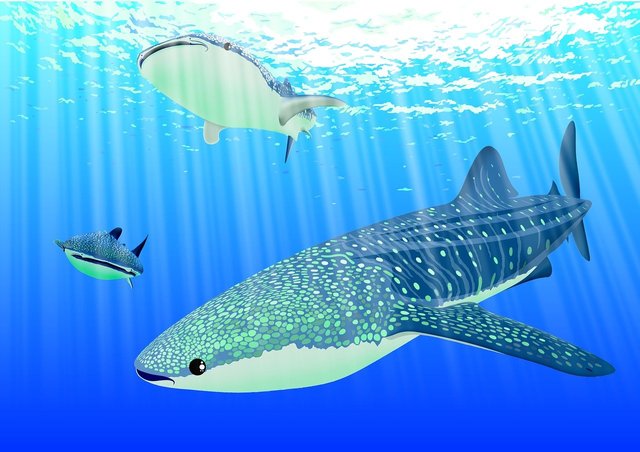 Image source Pixabay.com (Whale shark)
Image source Pixabay.com (Whale shark)
| Group | Order | Examples |
|---|---|---|
| Sharks | Scoliodon | Dogfish |
| - | Rhincodon | Whale shark |
| - | Carcharodon carcharias | The great white shark |
| Rays | Trygon | Stingray |
| - | Torpedo | Electric ray |
| Skates | Leucoraja erinacea | Little skate |
| - | Gurgesiella | Small deepwater skate |
| Sawfishes | Pristis clavata | Dwarf sawfish |
| - | Anoxypristis cuspidata | Narrow sawfish |
| Chimeras | Hydrolagus alphus | Whitespot ghost shark |
| - | Callorhinchus milii | Australian ghost shark |
Here I have completed my little work on Vertebrates, and this category is a vast section in the animal kingdom. So to learn, you can do more reading to understand more. This is not for anyone to rely on but to have basic Knowledge while doing more reading.